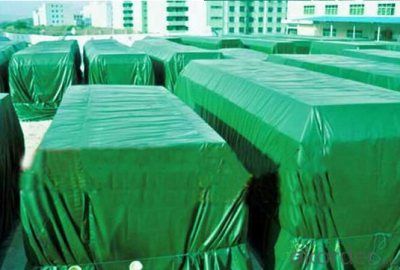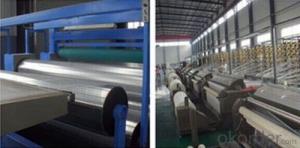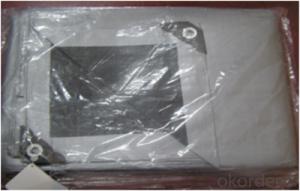Poly Tarps Ultra Violet Protection Factory 4*4,5*5,6*6,7*7,8*8,9*9,10*10,11*12,14*15
- Loading Port:
- Qingdao
- Payment Terms:
- TT OR LC
- Min Order Qty:
- 0.5
- Supply Capability:
- 12 m.t./month
OKorder Service Pledge
OKorder Financial Service
You Might Also Like
1. Descriptions for Poly Tarps
Product | pe tarpaulin of different usage |
Material | PE material |
Mesh | 4*4,5*5,6*6,7*7,8*8,9*9,10*10,11*12,14*15 etc. |
Weight | 50-300gsm |
Color | blue, silver,green, orange, white, dark blue, dark green and etc |
Size | according to customer's requirment, we have machine for heat-seal |
Coating | Laminated both sides |
Making | rope reinforced hem,heat sealed edges, every eyelet interval three feet or one meter, corners reinforced with triangle plastic sheets |
Features | waterproof, sun-resistant, anti-aging, anti-freeze and also can be Uv treated |
Usage | covering, trucks, boats, camping, farm equipment, tents, construction site etc |
2.Special Treatment
Different sizes and colors are available
Tear-resistant super durability minimized breakage during transportation and storage
Water-resistant and washable: it prevents contamination or damage from rain or moisture
Double waterproof surface.
Reinforced corners.
UV stabilized and sunproof
3. Specifications for Poly Tarps
Product | PE PVC Tarpaulin |
Material | HDPE,LDPE |
Weight | 65-250gsm |
Width | 1.83m,2m,2.44m,3.66m or 4m,available for wider fabric by heat sealing. Or as the customers requirement |
Size | Any sizes by the customers requirement |
Color | double green, double blue, double orange, blue-orange, blue-silver, green-silver, blue,white,red stripe and so on,any color as the customers requirement |
Making | Rope reinforced hem , heat sealed edges, every eyelet interval three feet or one meter ,corner reinforced with or without triangle plastic sheets as customers requirement. |
Features | sun-resistant,UV treated, lightweight, easy to fold, durable and other characteristics. |
Use | Tarpaulin is widely used for truck canopy,ship cover and cargo storage or transportation in mineral factories and ports, also can be used as tents in outside travel and calamities.The tarpaulin is to cover and protect the goods in the open air and avoid the goods get wet. |
Package | Packed in roll or in bales or cartons |
Delivery time | According to the quantity you want.Usually 15-30 days. |
Place of Origin: Shantou, China (Mainland) | Brand Name: TeeZoon | Model Number: as the customer’s request |
Produdct: PE tarpaulin | Product Type: PE fabric | Coated Type: PE laminated |
Color: | Use: truck cover | Weight: 150 gsm |
Technics: Woven | Width: 2m | Pattern: Coated |
Density: 12X12 |
4.Photos for Poly Tarps




- Q:Can geotextiles be used in riverbank stabilization applications?
- Yes, geotextiles can be used in riverbank stabilization applications. Geotextiles are commonly used to reinforce the soil and prevent erosion in riverbanks, helping to stabilize the slopes and prevent soil loss. They are effective in reducing water flow velocity, promoting vegetation growth, and providing long-term stability to the riverbank.
- Q:How do geotextiles contribute to groundwater protection?
- Geotextiles contribute to groundwater protection by acting as a barrier that prevents the movement of contaminants from the surface to the groundwater. They are used in various applications such as erosion control, filtration, and separation, effectively reducing the risk of pollutants reaching the groundwater and preserving its quality.
- Q:Roof geotextile isolation layer sets what the amount
- Polyester filament geotextile Features: Polyester filament geotextile is made by polyester method by spinning acupuncture consolidation directly made, product specifications from 80-800g / m2 arbitrary choice, it is geotechnical engineering and civil engineering In the application of a geosynthetics, polyester filament into a network and consolidation method, the fiber arranged in three-dimensional structure. In addition to good mechanical properties, but also has a good vertical and horizontal drainage performance and good extension properties and high resistance to biological, acid and alkali, anti-aging and other chemical stability. At the same time, it also has a wide pore size range, tortuous pore distribution, excellent permeability and filtration performance. Polyester filament geotextile Uses: water conservancy project dam and slope protection of the filter, channel isolation, seepage; road, rail, airport runway foundation isolation, filter, drainage, slope, retaining wall and road reinforcement, Drainage; Port Engineering soft foundation treatment, beach embankment, harbor wharf and breakwater reinforcement, drainage; polyester filament geotextile has been widely used in the field of infrastructure construction, and gradually applied to a wider range of areas.
- Q:How are geotextiles used in civil engineering projects?
- Geotextiles are used in civil engineering projects to provide reinforcement, separation, filtration, and drainage functions. They help stabilize soil, prevent erosion, and improve the performance of structures like roads, embankments, and retaining walls.
- Q:Do geotextiles require regular maintenance?
- Yes, geotextiles do require regular maintenance. This includes checking for any damage or wear, removing debris or sediment build-up, and ensuring proper drainage. Regular inspections and maintenance help to extend the lifespan and effectiveness of geotextiles in various applications.
- Q:Can geotextiles be used in slope stabilization projects?
- Yes, geotextiles can be used in slope stabilization projects. Geotextiles are often used to reinforce and stabilize slopes by providing strength and stability to the soil. They can help prevent erosion, control surface water runoff, and improve the overall stability of the slope.
- Q:How do geotextiles contribute to soil filtration?
- Geotextiles contribute to soil filtration by acting as a physical barrier that allows water to pass through while filtering out sediment and other contaminants. They help to prevent soil erosion, improve water quality, and enhance the overall stability and sustainability of soil.
- Q:How are geotextiles affected by UV exposure?
- Geotextiles are usually made of synthetic materials such as polypropylene or polyester, which can be negatively affected by prolonged exposure to UV radiation. UV exposure can cause degradation and weakening of the fibers, leading to reduced tensile strength and overall performance of geotextiles. To mitigate this, manufacturers often add UV stabilizers to enhance their resistance to UV radiation, thereby extending their lifespan and ensuring their effectiveness in various geotechnical applications.
- Q:How do geotextiles help with sediment control in water bodies?
- Geotextiles act as a physical barrier that prevents sediment from entering water bodies. They are designed to filter and separate sediment particles, allowing water to pass through while retaining the sediment. This helps in reducing erosion, improving water quality, and protecting aquatic ecosystems from the harmful effects of sedimentation.
- Q:What are the specifications for geotextiles in subsurface drainage projects?
- The specifications for geotextiles in subsurface drainage projects typically include requirements for the material's strength, permeability, filtration properties, and durability. These specifications ensure that the geotextile can effectively separate soil particles from the drainage media, prevent clogging, and maintain its functionality over time. Additionally, the specifications may also address the geotextile's dimensions, weight, and installation guidelines to ensure proper performance in subsurface drainage applications.
1. Manufacturer Overview |
|
|---|---|
| Location | |
| Year Established | |
| Annual Output Value | |
| Main Markets | |
| Company Certifications | |
2. Manufacturer Certificates |
|
|---|---|
| a) Certification Name | |
| Range | |
| Reference | |
| Validity Period | |
3. Manufacturer Capability |
|
|---|---|
| a)Trade Capacity | |
| Nearest Port | |
| Export Percentage | |
| No.of Employees in Trade Department | |
| Language Spoken: | |
| b)Factory Information | |
| Factory Size: | |
| No. of Production Lines | |
| Contract Manufacturing | |
| Product Price Range | |
Send your message to us
Poly Tarps Ultra Violet Protection Factory 4*4,5*5,6*6,7*7,8*8,9*9,10*10,11*12,14*15
- Loading Port:
- Qingdao
- Payment Terms:
- TT OR LC
- Min Order Qty:
- 0.5
- Supply Capability:
- 12 m.t./month
OKorder Service Pledge
OKorder Financial Service
Similar products
New products
Hot products
Related keywords
































